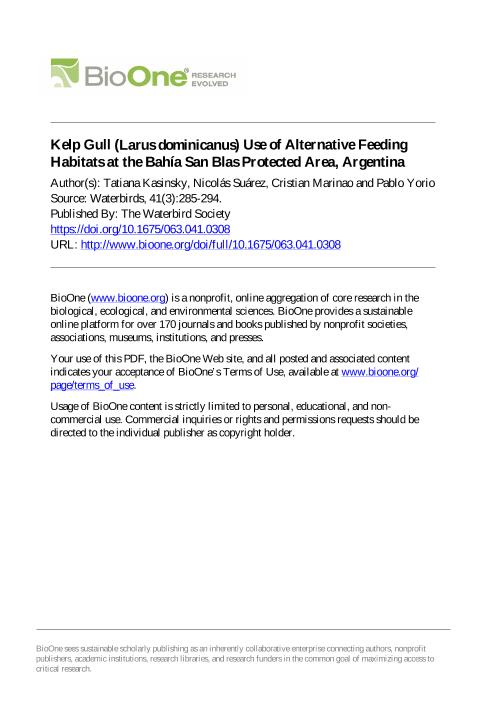Artículo
Kelp Gull (Larus dominicanus) Use of Alternative Feeding Habitats at the Bahía San Blas Protected Area, Argentina
Kasinsky Aguilera, Lorna Tatiana ; Suarez, Nicolas Marcelo
; Suarez, Nicolas Marcelo ; Marinao, Cristian Javier
; Marinao, Cristian Javier ; Yorio, Pablo Martin
; Yorio, Pablo Martin
 ; Suarez, Nicolas Marcelo
; Suarez, Nicolas Marcelo ; Marinao, Cristian Javier
; Marinao, Cristian Javier ; Yorio, Pablo Martin
; Yorio, Pablo Martin
Fecha de publicación:
09/2018
Editorial:
Waterbird Society
Revista:
Waterbirds
ISSN:
1524-4695
Idioma:
Inglés
Tipo de recurso:
Artículo publicado
Clasificación temática:
Resumen
Kelp Gull (Larus dominicanus) foraging patterns were studied by deploying GPS loggers on 20 incubating individuals at their colony in the Bahía San Blas protected area, Argentina. Mean number of trips per day was 1.5 ± 0.5, and mean trip duration was 272.6 ± 165.2 min. Mean maximum distance from the colony was 19.6 ± 24.4 km. Incubating Kelp Gulls visited natural and anthropogenic environments. Individuals switched between two or three different habitat types 47% of the time during a given foraging trip. Kelp Gulls showed a differential use of feeding areas, with a significantly higher use of refuse dumps (75%; n = 151 trips) than coastal (47%), terrestrial (10%) and offshore (10%) habitats. In 72% of the recorded trips, Kelp Gulls targeted the dump located in the small town of Bahía San Blas, where waste generated by recreational fishing is regularly disposed. Moreover, most visited shoreline locations were those regularly used by recreational fishers. Despite showing plasticity in foraging habitat use, the local refuse dump and nearby shoreline sites where fish waste is regularly disposed were the main feeding habitats for incubating Kelp Gulls.
Archivos asociados
Licencia
Identificadores
Colecciones
Articulos(CESIMAR)
Articulos de CENTRO PARA EL ESTUDIO DE SISTEMAS MARINOS
Articulos de CENTRO PARA EL ESTUDIO DE SISTEMAS MARINOS
Citación
Kasinsky Aguilera, Lorna Tatiana; Suarez, Nicolas Marcelo; Marinao, Cristian Javier; Yorio, Pablo Martin; Kelp Gull (Larus dominicanus) Use of Alternative Feeding Habitats at the Bahía San Blas Protected Area, Argentina; Waterbird Society; Waterbirds; 41; 3; 9-2018; 285-294
Compartir
Altmétricas



